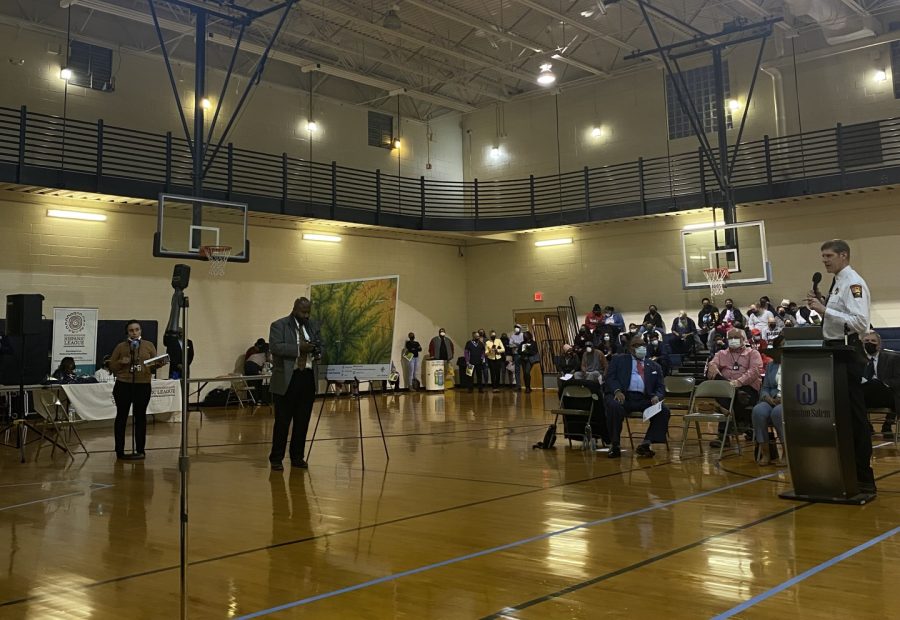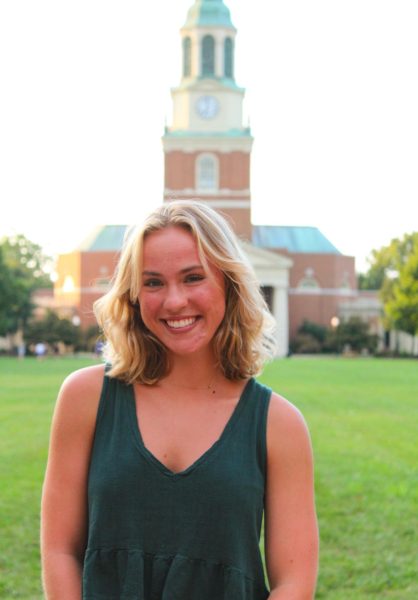City officials share information about Weaver Fire studies
Concerns about soil quality and air quality are still on residents’ minds
Fire Chief Trey Mayo addresses the public at a Feb. 1, 2023, public meeting.
February 9, 2023
Members of the Winston-Salem community gathered at Hanes Hosiery Community Center on Feb. 1 to address concerns and learn more about the Weaver Fertilizer plant fire’s lasting effects one year later.
“You don’t really know what happened until later, and that’s why it’s important to hear from the community,” Mayor Pro Tempore and Councilmember Denise D. Adams said, referring to the meeting as a time to update and reflect.
During a Q&A session at the end of the meeting, Winston-Salem residents voiced their concerns about poor air and soil quality following chemical exposure from the fire as well as how future incidents will be prevented.
When the Winston Weaver Co. fertilizer plant caught fire on Jan. 31 last year — putting 600 tons of flammable ammonium nitrate at risk of exploding — it prompted the evacuation of about 6,000 Winston-Salem residents, including 1,000 Wake Forest students and faculty. And while the cause of the blaze is still unknown, the meeting sought to provide clarity about ongoing efforts to study health effects and prevent future incidents.
City officials explained that the air quality within a one-mile radius of the Weaver Fertilizer plant returned to normal levels a week after the fire and that, as of summer 2022, there are no buildings with harmful amounts of ammonium nitrate left.
Officials also described newly adopted zoning ordinances for buildings, including a 25-acre land requirement for factories to dissuade construction in residential areas. Fertilizer plants also now require the highest level of approval for land use, according to Assistant City Manager Aaron King.
As part of an Atrium Health Wake Forest Baptist study on the fire’s long-term environmental and health effects, led by Wake Forest Medical School alumna Dr. Callie Brown, researchers conducted interviews at the meeting to collect data about Winston-Salem residents’ health. The study will interview a total of 40 residents and collect data from general health trends and hospitalizations within a two-mile radius of the fire, releasing assessments over the next two years.
Another part of the study, spearheaded by the Wake Forest Department of Engineering, includes an environmental assessment of the quality of air, water and soil within a two-mile radius of the Weaver Fertilizer plant.
“As the ones who sow the ground, we need to know what our soil looks like,” Adams said.
In addition to the study, the recently awarded Mellon Foundation Grant will fund efforts by the interdisciplinary humanities department to foster connectivity between Wake Forest students and the Winston-Salem community in understanding how to improve the city, according to Dr. Corey D.B. Walker.
“The project will link classrooms and the community at not just Wake Forest University but at Winston-Salem State [University] and more,” Walker said. “The fire brought into sharp relief the divergence between communities.”
The meeting also discussed the city’s $1 million relief fund — the disbursement of which was facilitated through a partnership with the non-profit organization Experiment in Self-Reliance, Inc. (ESR). The non-profit received 800 applications for assistance related to damages caused by the fire and provided assistance to 656 families, according to a Winston-Salem Journal report.
“Experiment in Self-Reliance was selected because we are accustomed to being there and [being a] shoulder to cry on,” Twana Roebuck, executive director of the nonprofit, said.
But the fund did not cover business losses — a gap that was covered by the Kate B. Reynolds Charitable Trust in partnership with Greater Winston-Salem Inc. The trust donated more than $250k for businesses struggling after the fire impacted their operations.
Additionally, much of the city’s Weaver Fertilizer plant fund — roughly two-thirds of its $1 million budget — was never distributed, raising questions about outreach, according to a Feb. 2 WFDD report. The report described the different outreach approaches used by Kate B. Reynolds Charitable Trust — which went door-to-door to assist businesses — and the Experiment in Self-Reliance, which reached out through a community information fair and website.
Further information will become available as it is released by the studies.















